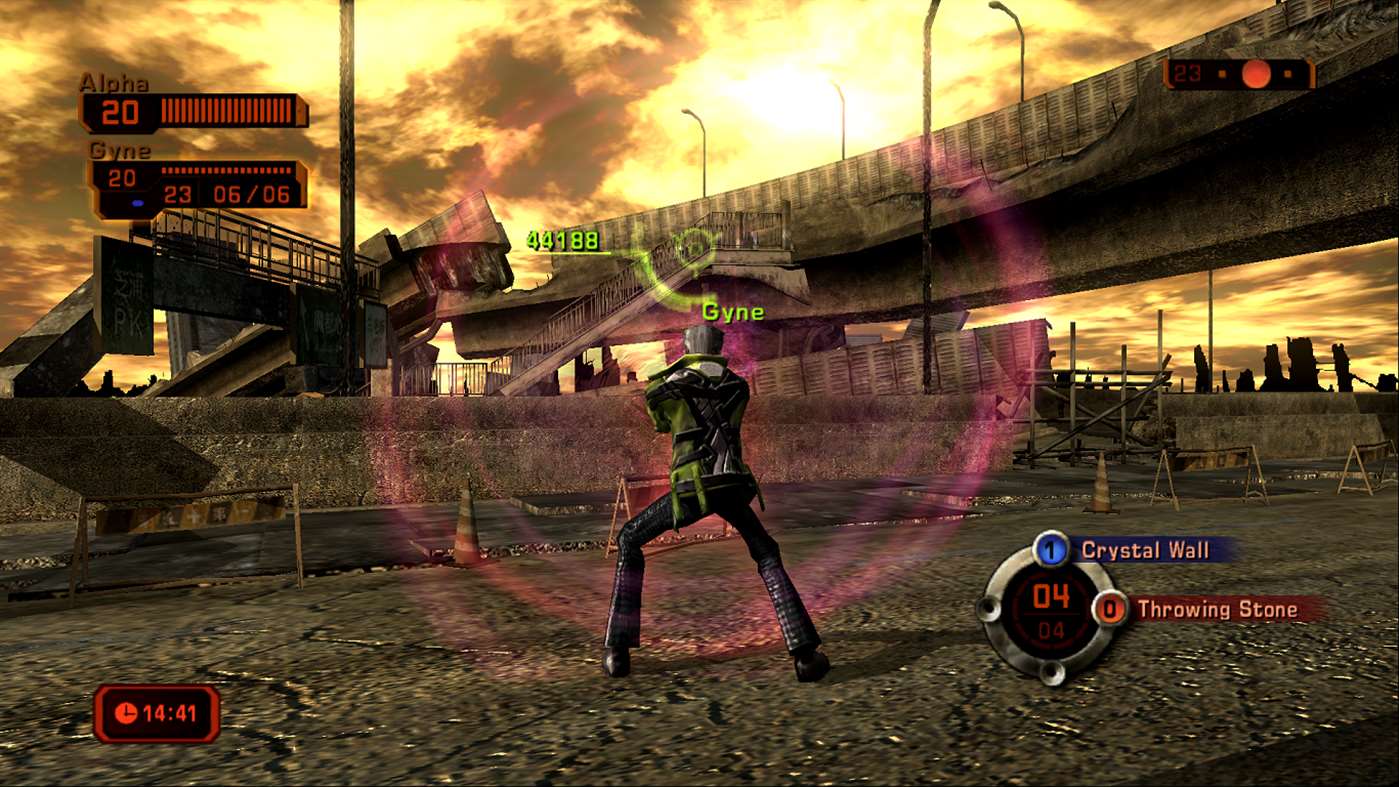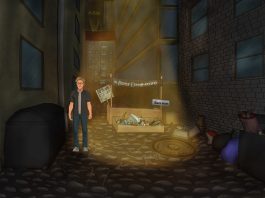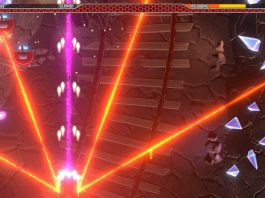Imagine, if you will, waking up in a completely changed world, with no memories of who you are or how you got to be there. This is the premise of Phantom Dust, which has been remastered by Code Mystics and released on Xbox One and PC. You play the part of Alpha, who along with your compatriot Edgar were discovered fast asleep in a pair of caskets, suspended high in the air.
As you are discovered and taken out of your sarcophagi, it is to a world that has been destroyed by a mysterious dust, and is now inhabited only by monsters. Any more than 15 minutes on the surface and the dust leads to memory loss, so mankind now lives underground in a bunker. As a side effect of the dust, certain humans are now known as Espers, and have developed powers that allow them to utilise some aspect of the dust, and turn concentrations of it into weapons or defenses. The best of these, known as scouts, go and explore the world, bringing back artifacts and helping to expand the knowledge of what came before. As luck would have it, both Edgar and Alpha are able to become Espers and scouts, and so the story revolves around what happens next.
The original game of Phantom Dust was released way back in 2004, for the original Xbox. I never played it in those days, being a PS2 boy, but despite its lack of critical success, the game went on to garner a large cult following. Microsoft sought to use this game to try and get the game playing public in Japan onboard with the Xbox, bringing in the director of Panzer Dragoon, Yukio Futatsagi, to design and produce the game. This is obvious in the graphical style, which is heavily stylised, with all the characters almost looking like caricatures of regular NPCs. Even our character, Alpha, looks emaciated and almost skeletal, a long way from the normal, heavily muscled sterotypes of game heroes.
This game also seems to have been something of a poisoned chalice, as the studio that were first charged with bringing the game up to date, Darkside Game Studios, were shutdown when Microsoft cancelled the remaster, citing monetary issues. However, the remake finally saw the light of day in May 2017, and has been developed as a cross play title with Windows 10. This works absolutely brilliantly, and as the game isn’t graphically intensive, I can even run it on my low end laptop with an Xbox controller plugged in, allowing my progress to be kept from either platform. This is my first real use of the Play Anywhere scheme, and I can see now why everyone was so excited about it.
So, on firing up and logging in, the whole vibe of the startup screens is unashamedly retro. The screen is in the 4:3 format and only in the middle portion, there’s simulated screen roll and it’s like being back in the early 2000s. Once you’re in and past the cutscenes (which have quite possibly the most comical dubbing I’ve ever seen – we’re talking 1970’s martial art film style here), the screen opens up to become full again and you’re in charge of Alpha. You’re in the underground world – the hub world for the characters that you need to interact with and shopkeepers you need to deal with and so on. It’s a fairly simple layout to memorise, with various different levels and places to go, such as the Lab, Mac’s Shop and the Battle Terminal.
But it is here where I started to get annoyed with the game, as there is absolutely no indication of what you need to do. The first two levels are, by and large, tutorials, and so you are led by the hand to a certain degree, told who to speak to and where they are. After this, it’s a free for all. I had been doing missions for a character called Ubiquitous in the Lab (the characters all have weird names, it’s a side effect of having no memory and not knowing who they were). After a while, all he would say to me was “I’ll wait… a little longer”. That’s it, no clues about how to drive the story on, no new missions. Just “I’ll wait”. So then I had to run all over the underground hub world, speak to everyone I could find until I could then do the mission I needed to to move on. Would a clue be too much to ask? Maybe a marker on the mini-map to show that someone wants to talk to me?
When you successfully find someone who needs a mission completing, the game moves into the other phase, that of exploring on the surface. When you accept a mission, you are given the rundown on what needs hitting, but largely they boil down to “kill some stuff”. As you advance, you’ll also be given the chance to choose which of your pre-configured Arsenals to bring along, and you’ll also see which of the NPCs are going to accompany you on the trip.
Once you spawn in, a 15 minute timer starts to count down, as after this your memory will start to be affected. I wouldn’t worry too much about the timer, as I’ve never had it run out – I’m usually dead or successful well within the time limit! As you utilise attacks, or defend yourself using skills, a certain amount of Aura is deducted from your store. Aura is Phantom Dust’s power points system – each attack, defend or skill takes a set number of points to cast and they recharge and count up after you use them. In the first couple of Chapters you have around five Aura points to play with, and after that it depends on what you have in your Arsenal.
The overworld looks suitably post apocalyptic, with broken palaces and stretches of highway being the scene for much of what follows. The scenery isn’t just there for decoration though, as it appears to be destructible, and half a ton of masonry falling on your head can have a detrimental effect on your health bar. Be careful when flinging the attacks about!
The attacks and other moves that you can utilise spawn near your starting point in the world, and come in the form of spheres of concentrated dust. Red spheres are attacks, which can be short, mid or long range, and in a nice touch the reticle when you are locked onto an enemy changes colour depending on how far away they are. Green reticles signify the enemy is at long range, yellow is mid range and red is up close and personal. So using the correct attack at the correct time is critical. Long and medium range attacks at close range will miss completely and be a waste of your Aura, so you’ll need to think carefully. Defense skills spawn in blue spheres, and these are the most common types that you will come across. Yellow spheres give you superpowers, almost, like Levitate which flings you 30 feet into the air, or Dash which allows you to dodge attacks at the last minute. Green spheres contain powers that change your status, like Heat, which increases your attack but decreases your speed, making you more vulnerable.
As you approach the spheres that spawn in, the face button that you press when you are near the sphere is the button that will be assigned to that particular skill. So if, for instance, Fire Bullet spawns and you press A to pick it up, the A button will fire that attack each time it is pressed – as long as you have enough Aura. You can replace that power with another by standing near a different sphere and pressing A, overwriting the power that you previously had. In addition, some attacks are multiple use, whilst others will vanish after being fired off. These usually have a zero Aura cost, so are easy to spot.
The enemies that you fight, whether they be the AI or PvP, can also use the same range of attacks, so tactical thinking is very important. It’s no good building an arsenal of long range moves if the fight is going to take place in the cramped confines and stairwells of a ruined palace. Likewise, a short range heavy series of attacks are going to be next to useless on the wide open Highway sections. Planning ahead will win the day here.
Once you get past Chapter Two, the game gives you a way of choosing which powers to use in any situation. These are the Arsenals, allowing you to store a series of moves, which you can choose to take to the surface. The Arsenals are explained as capsules of concentrated Dust with powers in, that you shatter when you get to the surface, causing your chosen moves to be available. The only fly in the ointment is that the order that the spheres spawn into the map is random, so it’s entirely possible that you won’t see an attack sphere spawn for three or four minutes.
In addition to skills, each Arsenal contains Aura capsules, which when picked up give you additional Aura points. Once your maximum Aura has been increased, by picking up these spheres, that’s the level that they will recharge to. Again you’re faced with a choice: should you build up your Aura first, then grab an attack, or grab one straight away and go on the offensive? This then is when Phantom Dust is at its best, when you are planning your strategy before the bullets/energy blasts begin to fly.
With the flexibility afforded by the Arsenal system, you can have a different hand each time you hit the surface, and this adds a large degree of replayability. If you feel that you need more skills, there is a shop where you can either buy the skill you want for a premium, or purchase Junk which will give you five random skills to add to your hand.
So this then is how the single player, or Scenario mode as it is called in-game, pretty much works – complete missions, fight a boss, talk to more people, grab more missions and then rinse and repeat.
There is however also a multiplayer mode, available for either online or local split screen players. Intriguingly, you can also play against PC players in the multiplayer section of the game, so the possible playerbase for Phantom Dust is quite large.
However, there just doesn’t seem to be that many people playing the game and there have hardly been any quick matches available to me. Creating a lobby and waiting does enable the chance to play with real life enemies, and the trouncing that I’ve suffered goes a long way to explaining why preparation is key! There is a free Arsenal in the Online Store section of the multiplayer section that is worth downloading, as wading into battle with little more than harsh language goes at least some of the way to explaining my numerous defeats. There is a separate section where it is possible to buy skills or junk to help rank up your online Arsenal, and the credits that you earn in Scenario mode can be put to use here as well.
In conclusion and Phantom Dust is the very definition of a game of two halves. The underground hub sections are dull, with little in the way of signposting or hand-holding to make the time spent there as small as possible. The overground mission sections are fast paced, tactical and, above all else, fun to play with a myriad of ways to approach the missions. Add to this the online fight options and the scales come down on the fun side.
But whilst the story and setup is interesting, I just wish that they could have found a way to make the hub sections less dull.
Still, for a free game you can’t complain about the value…














